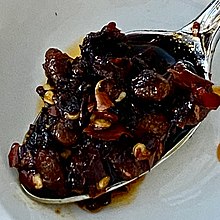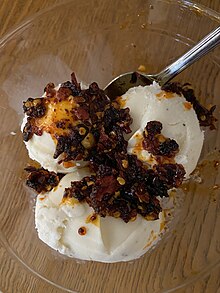 | |
| Place of origin | China |
|---|---|
| Main ingredients | chili pepper, soybean oil |
Chili crisp, chile crisp or chili crunch (Chinese: 香辣脆; pinyin: Xiāng là cuì) is a type of hot sauce, originating from Chinese cuisine, made with fried chili pepper and other aromatics infused in oil, sometimes with other ingredients. Multiple regional, homemade, and restaurant-original versions exist across China. The best-known commercial brand is Lao Gan Ma, which is based on the chili crisps of Guizhou province. The chili crisp is closely related to Chinese chili oil, and sometimes the two terms are used interchangeably, the difference being that the crisp contains edible chunks of food in the chili oil.
History
Infused-oil hot sauce condiments have been made and used in China for centuries and multiple regional variations have developed over time. In southern China it is more common to simmer the ingredients in the oil, while in the north it is more common to pour hot oil over the ingredients. Households and restaurants developed their own versions, and in China "almost every restaurant makes their own", according to chef and restaurateur Lucas Sin.
In 1997, Chinese restaurateur Tao Huabi began the first commercial production of chili crisp in Guizhou under the Lao Gan Ma brand, which quickly became popular and eventually became a Chinese pantry staple. Although it was consumed by Chinese Americans, it was not widely known in the United States until the late 2010s and became particularly popular in the US during the coronavirus pandemic. The New York Times called it "a quarantine cooking need". The condiment has a fan base often described as "cult-like", referring to intense popularity.
As of 2024, David Chang's Momofuku holds the US trademark to the term "chile crunch" and has filed for protection for "chili crunch" as well.
Description and ingredients
Chili crisp is an oil-based condiment that contains crunchy bits of chili pepper, usually along with other spices such as garlic, onions, scallions, or other aromatics. It is related to chili oil and to chili sauce, and sometimes the terms are used interchangeably to refer to it. Chili crisp's proportions are such that the condiment contains much more crunchy bits than oil, which creates the texture of the condiment. It is typically not pourable like chili oils and chili sauces but instead is spooned over or stirred into dishes, and unlike chili oils and chili sauces it is not typically used in cooking but instead is added to foods before serving. Some recipes for chili oil call for making a chili crisp–like product, then straining out the solids.
Sichuan pepper is a common traditional ingredient. Rapeseed oil or soybean oil are common bases. Vinegar, which is commonly used in hot sauces, is not an ingredient.
Flavor profile
Chili crisp is savory, salty, spicy, and oily. Today described chili crisp as "a flavor bomb, incredibly nuanced, usually spicy, full of umami". The Los Angeles Times described the flavor as "the salty, crackly pleasure of potato chips with a just-right amount of tingling chile heat". New York magazine described it as "balanced the way sriracha is, only with more crunch and oomph". Chili crisps containing Sichuan pepper provoke an "intense heat and numbing sensation" typically associated with mala.
Besides the actual flavors, much of the appeal is often attributed to the texture.
Uses

It has been described as being good with "anything" and "everything", including desserts. Sam Sifton described it as "magical" and "a condiment to improve all it touches". Lucky Peach listed it among their pantry staples, saying:
Do you need this? Not quite. Do you want this? Most definitely a signifier to other food nerds that you crossed the sriracha river into the land of freaky-deaky hot sauces that will never be trendy.
Chili crisp is typically used as a condiment rather than as a cooking ingredient. It is used to top many different dishes, such as avocado toast, tacos, eggs, fish, vegetables, salads, fruit, grains, peanut brittle, or vanilla ice cream. It is spooned onto or stirred into soups and broths. It is tossed into noodles or used to top them. It is used as a dip or spread.
Jing Gao, who makes an artisan chili crisp, called topping ice cream with the condiment an example of hei an liao li, a term used on the Chinese internet for bizarre food combinations that translates to "dark cuisine".
Production
Various techniques are used, including simmering the ingredients in oil and pouring hot oil over the ingredients. To enhance the crispiness, moist ingredients such as onions are simmered in the oil separately first to eliminate their liquids.
Variations
Variations of chili crisp appear in various parts of the world, but are most commonly found in Taiwan, Japan, and Mexico, often with local ingredients such as árbol chiles and sesame seeds. Lao Gan Ma remains the largest chili crisp company, with annual sales reaching $835.6 Million USD in 2020.
See also
References
- Tomky, Naomi (16 November 2019). "老干妈有对手了,这款辣酱走红美国" [Lao Gan Ma Has a Rival, This Hot Sauce Goes Viral in the US]. 手机财富中文网 (Fortune China). Retrieved 21 December 2023.
- ^ Rao, Vidya (3 June 2021). "What is chili crisp? This spicy condiment belongs on everything – even dessert". Today. Archived from the original on 3 June 2021. Retrieved 27 November 2021.
- ^ Ko, Genevieve (15 May 2020). "Obsessed with chili crisp? Here's how to make it extra crunchy". Los Angeles Times. Archived from the original on 16 May 2020. Retrieved 7 February 2021.
- Schroeder, Lisa Golden (14 July 2021). "Spicy chili crisp is the condiment you don't want to be without". Star Tribune. Archived from the original on 14 July 2021. Retrieved 27 November 2021.
- ^ Park, James (3 March 2021). "The Ultimate Guide to Chile Crisps". Eater. Archived from the original on 3 March 2021. Retrieved 27 November 2021.
- ^ Laperruque, Emma (3 May 2019). "Why Chili Crisp Is the Condiment I Put on Literally Everything". Food52. Archived from the original on 10 June 2019. Retrieved 7 February 2021.
- ^ Walsh, Karla (6 July 2021). "Chili Crisp Is the Chinese Condiment We're Adding to Noodles, Desserts, and SO Much More". Better Homes & Gardens. Archived from the original on 8 July 2021. Retrieved 27 November 2021.
- ^ Erway, Cathy (4 May 2020). "Chile Oil Is So Hot Right Now". Eater. Archived from the original on 5 May 2020. Retrieved 27 November 2021.
- ^ Sifton, Sam (13 April 2020). "Your Quarantine Cooking Needs Condiments". The New York Times. ISSN 0362-4331. Retrieved 27 November 2021.
- ^ Erway, Cathy (14 November 2018). "The Cult of Spicy Chile Crisp Is Real". Taste. Archived from the original on 20 May 2019. Retrieved 27 November 2021.
- Roberts, Nina (4 April 2024). "'Trademark bully': Momofuku turns up heat on others selling 'chili crunch'". The Guardian.
- ^ Hopkins, Tiffany (10 July 2019). "The 5 Best Crunchy Chile Sauces You Can Buy Online". Epicurious. Retrieved 7 February 2021.
- Leimkuhler, Mia (10 January 2018). "I Panic If I Don't Have at Least 5 Jars of This Spicy Chili Crisp". The Strategist. Archived from the original on 11 January 2018. Retrieved 27 November 2021.
- ^ López-Alt, J. Kenji (30 June 2020). "Chile Crisp Is Even Good With Ice Cream". The New York Times. ISSN 0362-4331. Retrieved 7 February 2021.
- ^ El-Waylly, Sohla (6 May 2020). "Homemade Spicy Chili Crisp Recipe". Serious Eats. Archived from the original on 6 May 2021. Retrieved 27 November 2021.
- Meehan, Peter (2015). Lucky peach presents 101 easy Asian recipes (First ed.). New York: Clarkson Potter. ISBN 978-0-8041-8779-4. OCLC 907931361.
- López-Alt, J. Kenji (30 June 2020). "Sichuan Chile Oil Recipe". NYT Cooking. Archived from the original on 30 June 2020. Retrieved 7 February 2021.
- Stein, Scott (10 March 2021). "How spicy chili crisp can change your life: A pandemic story". CNET. Archived from the original on 10 March 2021. Retrieved 27 November 2021.
- ^ Falkowitz, Max (1 November 2018). "People in Sichuan Are Lining Up for Spicy Chile Oil Soft Serve, and It's Actually Great". Food & Wine. Archived from the original on 2 April 2020. Retrieved 27 November 2021.